Charts of the Week
Current economic trends from 31 May to 4 June 2021: consumer prices, traffic of electronically tolled vehicles, electricity consumption, fiscal verification of invoices, registered unemployment and other charts
In the first quarter of this year, real GDP increased compared to the previous quarter and exceeded the levels of the same period last year. Growth continued in the export-oriented part of the economy, and with the lifting of the containment measures, services and private consumption also began to recover. Favourable trends were also seen in the labour market, but the situation remains tight. The further easing of the containment measures in May had a favourable effect on turnover, which was higher in the second half of the month than before the epidemic. Freight traffic on Slovenian motorways and electricity consumption were slightly lower in the last week of May than in the same period before the epidemic. The increase in consumer prices was higher in April and May than in the previous months, which, in addition to the current increase in the prices of petroleum products, was mainly due to higher energy prices compared to the previous year as a result of the low base effect.
Consumer prices, May 2021
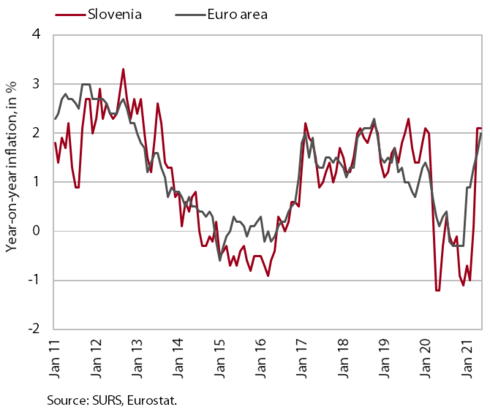
In May, consumer price growth remained at 2.1%. Most of this growth was still the result of higher year-on-year energy prices (petroleum products and electricity), mainly due to a lower base and, to a lesser extent, current growth in petroleum product prices. After the prices of semi-durable goods at the beginning of the year had been well below the year-earlier level, their growth has gradually strengthened in recent months, reaching 1.6% in May. According to our estimates, this was again mainly due to clothing and footwear prices, as prices of new collections rose more than in previous years. The prices of durable goods also rose at a similar rate as a year earlier. Prices in the food and non-alcoholic beverages group and services remain lower year-on-year (by -2.5% and -0.6%, respectively). The fall in prices of package holidays intensified in May with the opening of some accommodation activities, while the prices in the communications group picked up again.
Traffic of electronically tolled vehicles on Slovenian motorways, May 2021
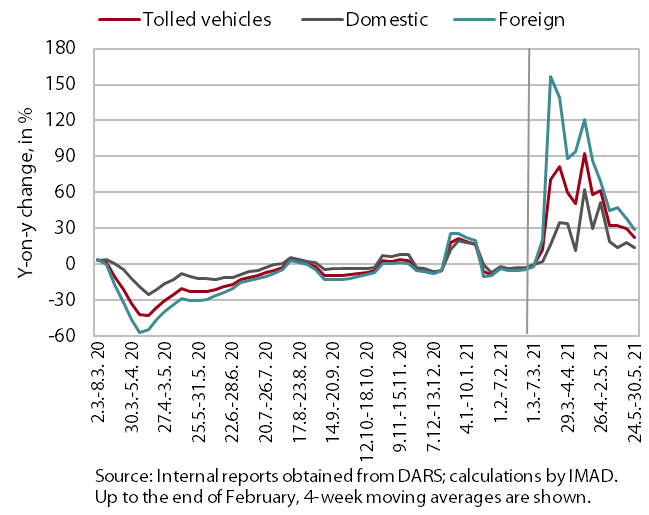
Freight traffic on Slovenian motorways in the last week of May was 23% higher than in the same period of last year but 3% lower than in the same period of 2019. Due to Pentecost Monday holiday in some neighbouring countries, the volume of freight traffic was slightly lower than in the previous week and also compared to the same week of the pre-crisis year 2019 (4% higher for domestic vehicles and 7% lower for foreign ones). Between 24 and 30 May, domestic vehicle traffic was 14% higher and foreign vehicle traffic 29% higher year-on-year. This strong year-on-year growth was still mainly a consequence of lower traffic in the same period of last year due to the first wave of the epidemic (when freight traffic of foreign vehicles declined more).
Electricity consumption, May 2021
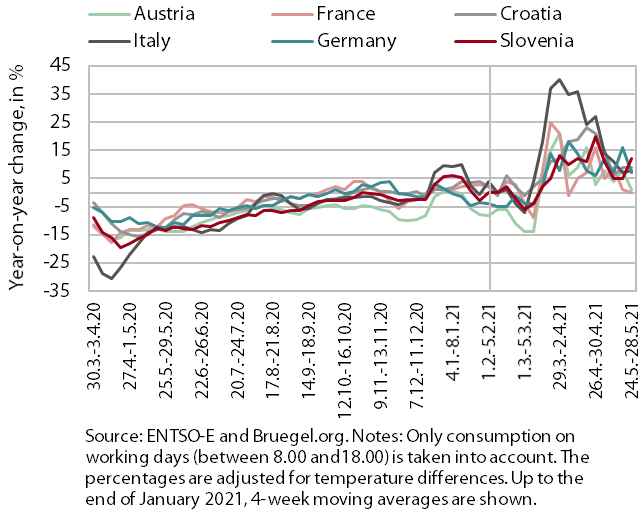
In the week between 24 and 28 May, electricity consumption was 12% higher than in same week of 2020 but 6% lower than in the same week of the pre-crisis year 2019. The reason for the year-on-year higher consumption was last year’s low base. However, consumption remained lower than before the crisis despite the relaxation of a number of containment measures. Particularly due to the base effect, year-on-year higher consumption was also recorded in Slovenia’s main trading partners (from 1% in Austria to 12% in Slovenia), except in France, where it was the same as last year. Relative to the same week of 2019, consumption was down in Austria (7%), Italy (6%), Croatia (5%) and France (4%), while consumption in Germany was 4% higher.
Fiscal verification of invoices, May 2021
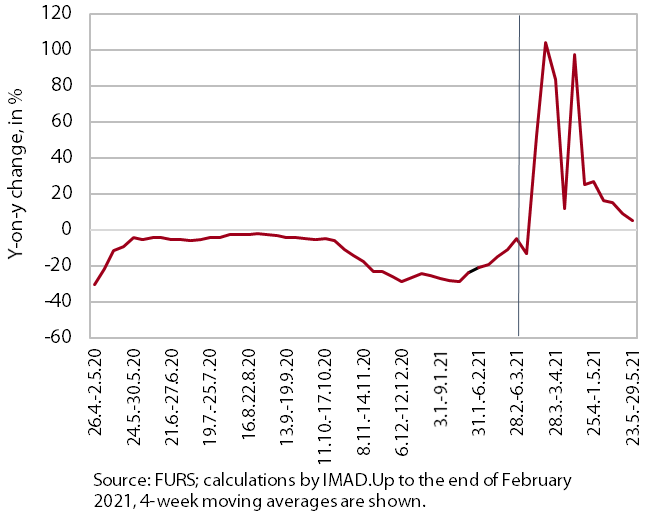
According to data on fiscal verification of invoices, in the second half of May turnover was 7% higher year-on-year and 4% higher than in the same period of 2019. In most sectors, year-on-year growth in turnover moderated, as measures in previously severely restricted sectors (tourism, clothing stores in shopping malls) were at least partially relaxed in mid-May last year or turnover even fell year-on-year in those which saw a significant increase in sales with the renewed opening last year (e.g. some personal services). Total turnover in the second half of May was 4% higher than in the same period of 2019, which was mainly a consequence of growth in wholesale and retail trade. Turnover in services that were still highly restricted (cultural and entertainment services, accommodation, travel agencies, gambling and betting) remained significantly lower than in the same period of 2019 (between -68% and -86%).
Registered unemployment, May-June 2021
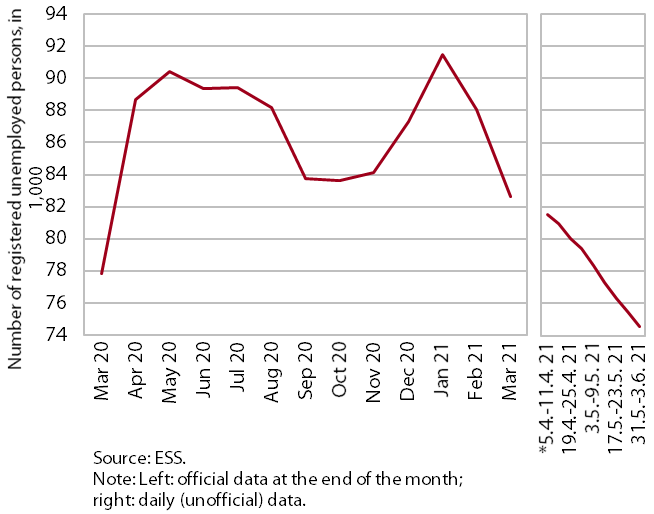
The number of registered unemployed persons fell further at the beginning of June. In May, the decline in the number of unemployed strengthened slightly and this trend continued in the beginning of June. Amid seasonal impacts, which did not deviate significantly from those in the period before the epidemic, the decline was also related to the gradual relaxation of containment measures as well as economic recovery and improved situation in the labour market. On 3 June, 73,924 persons were unemployed according to ESS unofficial (daily) data, which is 1.6% less than at the end of May and around 17% less than one year earlier. Compared with June 2019, the number was, however, around 4% higher.
GDP, Q1 2021
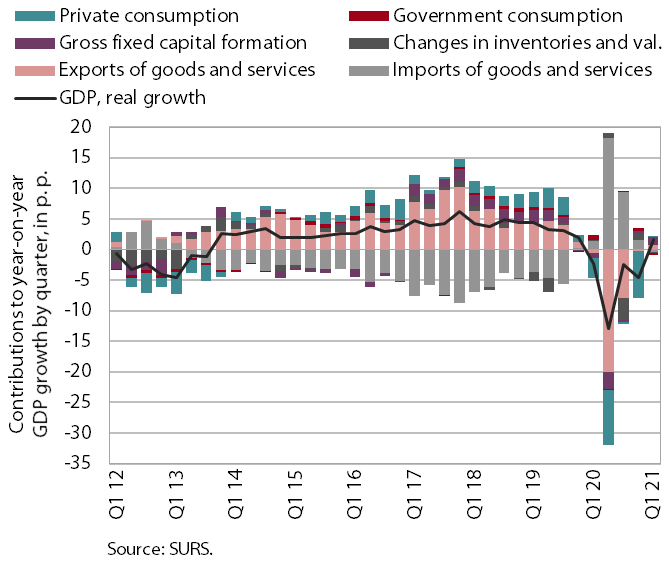
In the first quarter 2021, gross domestic product (GDP) increased compared to the previous quarter, by 1.4%, and by 1.6% year-on-year. Growth was higher compared to the EU average. Developments reflect a slightly better epidemic situation and the gradual easing of containment measures, as well as the adjustment of the economy and consumers to the changed conditions. The recovery continued, particularly in service activities related to international trade in goods (transportation and export-oriented manufacturing activities). Gross fixed capital formation increased year-on-year for the second consecutive quarter. Turnover in trade, which had already largely eased in February, was also up year-on-year for the first time since the beginning of the epidemic, partly due to the making up for foregone purchases and partly due to increased spending ahead of the announced lockdown in early April. This led to a slightly higher year-on-year private consumption. However, the containment measures continued to have a significant impact on a sharp year-on-year decline in some services, which opened more slowly, notably entertainment, sports, recreational and personal services and hotels and restaurants, which hampered faster growth in household spending. Real government consumption fell year-on-year.
Active and inactive population, Q1 2021
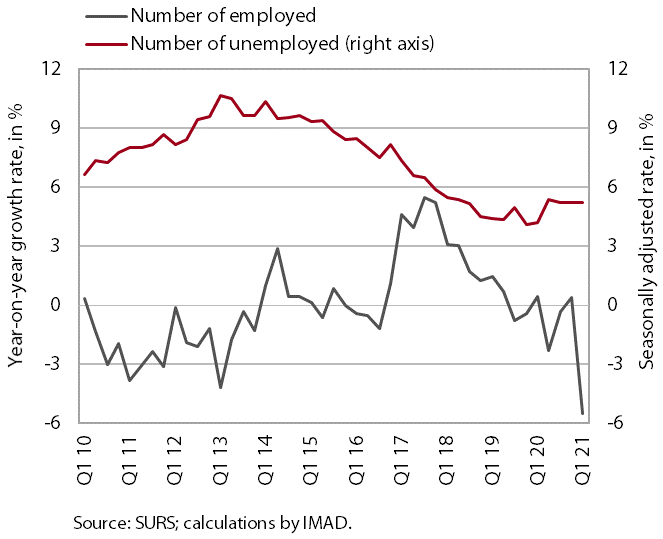
According to the survey data, labour market conditions improved slightly in the first quarter but remained worse than in the same period last year. According to seasonally adjusted data, the number of unemployed decreased by 2.2% compared to the previous quarter, but was still 19.1% higher than in the first quarter of last year. The survey unemployment rate increased year-on-year by 1 p.p., to 5.6%. The number of employed persons fell by 5.5%, largely due to the change in methodology.
